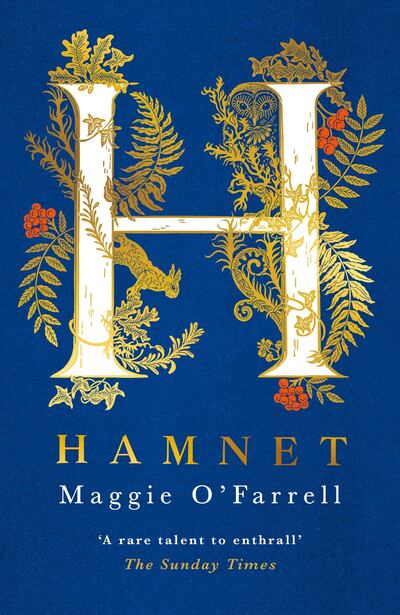"What is in a name?" Juliet asks Romeo. Names matter in Maggie O'Farrell's latest novel. It comes with a short dedication – "For Will" – which presumably refers to the author's husband, William Sutcliffe, but could as plausibly denote one of her protagonists, William Shakespeare.
Not that O’Farrell ever calls him Will in the book. In fact, she does not name him at all, perhaps not to overshadow her other pivotal characters. One of them is Shakespeare’s wife, who in O’Farrell’s book is not Anne but Agnes.
The other is the couple’s only son, Hamnet, whose name provides the book’s title and whose premature death and aftermath make for a poignant and powerful read.
Hamnet died in 1596 at the age of eleven. Little was known about him or indeed
Hamnet died in 1596 at the age of 11. Little was known about him or indeed the rest of his family. But instead of viewing scant historical details as an artistic dead end, O’Farrell has treated it as an ideal opportunity to exercise creative licence.
With skill, empathy and intelligence, she reimagines individual lives and shared fates. The result is O’Farrell’s finest work to date. Probably no wonder then, that she should be nominated for the Women's Prize for Fiction for the effort.

The novel opens in Stratford-upon-Avon with a flustered Hamnet searching for help. His twin sister Judith has fallen ill with a high fever and weak pulse, but no one is at home: his father is two days’ ride away in London and his mother is tending her patch of land.
Worse, the physician is on call and the maid who answers the door to him asks if his sibling has buboes. Panic turns into cold fear, for Hamnet knows such swellings under the skin are a sure sign of “the pestilence”.
From here, O’Farrell takes us back to when Shakespeare was 18 and forced to teach Latin to boys to help pay off his disgraced father’s debts. One day, he looks out of the window and is transfixed by a young woman with a kestrel in the garden.
This is Agnes, whose reputation precedes her. Local legend has it that she has special powers: not only able to predict the future but also to “see into people’s souls”. The pair meet and click, despite an age-gap of eight years. Shakespeare considers her “peerless”; unfortunately Agnes’ stepmother brands him “wageless, useless, beardless”. But an accidental pregnancy leads to an expedient marriage, after which Agnes swaps country for town and joins her new husband in the narrow apartment adjoining his parents’ house.
O’Farrell’s narrative shuttles between this relatively calm past and the high-stakes events with Judith and Hamnet 15 years later. Her backstory unfolds to describe Shakespeare going nowhere fast in his small market town and leaving try his luck in London – first acting in, then writing for, the city’s playhouses.
O’Farrell’s other thread is equally absorbing but substantially more emotional. There is pathos as Hamnet decides to “hoodwink Death” and save his sickly sister by lying beside her on her pallet and breathing in the contaminated air. “You will stay, is what he whispers, and I will go.”
This gives way to wrenching sadness when his stratagem works and Agnes returns to discover that one child has recovered and the other is now plague-ridden. It isn’t long before this fiercely strong and gifted woman, whose herbal potions and tinctures have cured people from all over town, is rendered weak by the realisation that she is unable to cure her own son.
As with O'Farrell's previous novels, The Vanishing Act of Esme Lennox (2006) and Instructions for a Heatwave (2013), Hamnet is a family drama involving absent parents and strained relationships. However, with this more ambitious book she delivers a richer reading experience, one which impresses on virtually every level.
To celebrate the reveal of the 2020 #WomensPrize shortlist (and to relieve one person's lockdown boredom), we're giving away a set of all six shortlisted books 📚
— Women's Prize (@WomensPrize) April 22, 2020
To #win, retweet this and comment with the shortlisted book you're most looking forward to reading. pic.twitter.com/oOBANGVju8
Distant, hazy, barely known factual figures are transformed into intensely human fictional equivalents. Even the minor characters leave their mark, from Agnes’ domineering stepmother Joan to Shakespeare’s tyrannical father John. The period detail rings true: we are fully, convincingly immersed in Elizabethan England. The present-tense narration brings to mind Hilary Mantel’s Thomas Cromwell novels: this is happening now, not in a dusty, forgotten past. O’Farrell couldn’t have known that the book’s cruel plague gives the proceedings an air of grim topicality.
What she must surely have known was the effect of her magical prose. Her original imagery captivates: Agnes’ heart thuds in her chest, “an animal hurling itself against its cage of bones”; the scratch of Hamnet’s quill is like “the sound of hens’ feet in the dirt.” There are diverting side-stories about the origins of the plague and the journey of a letter, plus a cathartic last act which shows how Shakespeare produced great art while stuck in “a web of absence".
Both a compelling tale and a searing study of grief, Hamnet marks a career-high for this most versatile of writers.







